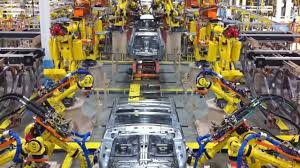Imagine yourself in a factory that produces cars. What would you see first, is it humans or robots? In a 21st century perspective, it is natural for the image of robots to appear first before humans because it is what currently dominating our industry. Robots are needed to build our cars instead of human because now that the population is at 7 billion people, everyone requires the convenience of transportation. The main transportation for majority of people in the world is cars because it is private and it is available at any time for us to use, instead of public transportation where there is a schedule to follow. Humans cannot mass produce cars in a short amount of time; thus, it is inevitable that eventually, robots would replace humans in the manufacturing of cars. In the automation industry, there are many types of automation that can be found. As the industry grows over the year, people discover more and more ways to expand automation to fit better into the needs of many different sectors. This article would list three different types of automation in factory manufacture.

1 – Fixed automation
Fixed automation refers to the fixed sequence of processing operations by the equipment configuration. In other words, it has a fixed set of operation and it is configured to operate effectively. These programmed instructions are contained in various forms like, cams, gears, wiring and many others. The product style of these hardware is not easily changed over which is why it is considered fixed. It is categorized by high initial investment and high rate of production. This automation is typically used in mass production with a continuous flow. For examples, distillation processes, transfer lines and conveyors and many more. To achieve high output volumes, all these processes depend on mechanised machinery.
The purpose of this automation is to produce products in batches. The products can be produced in range between few dozens to few thousand at a time. Every time there is a new batch to be produced, the equipment must be reprogrammed to accommodate to the new product design. The time it takes to reprogram the equipment would take quite some time so in this automation there will be a period of nonproductive because they need to reprogram the equipment. Then after they have reprogrammed it, they would have a period of production run for new batches and this is a cycle that keeps going. This contributes to low production rates because rather than specializing in one thing, the machine is built to adapt to product changeover. Industrial robots are a perfect example of a programmable automation.
3 – Flexible automation is considered as an extension of the second automation. For the programmable automation, it requires time to reprogram it every time which brings a disadvantage due to the fact that there is a period of nonproductive. When there is a lost production time, it costs the company a lot of money. Thus, people created flexible automation where limitation of variety of products lead to faster changeover time and it can also be done automatically. This is done off-line so that the programming does not have to be keyed into the equipment itself but rather, a computer terminal.
These are the evidence of progression in the development of automation in manufacturing. Even here, there are many companies involved in industrial automation in Malaysia that uses these types of automation such as top Malaysia moxa converter.
